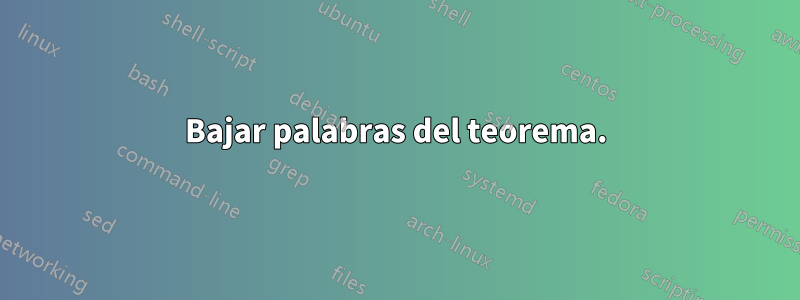
Tengo un teorema que dice así:
\documentclass[12pt]{book}
\begin{document}
\newtheorem{definition}{Definition}[section]
\begin{definition}[Integers]
Integers are positive and negative whole numbers, including 0.\\
e.g. $..., -3, -2, -1, 0, 1, 2, 3, 4, ...$
\end{definition}
\end{document}

¿Cómo hago para que la afirmación "Los números enteros son positivos y negativos..." baje 1 línea?
Lo he intentado \\ pero eso creará un error sin línea para finalizar y tampoco elimina el mensaje "Los enteros son positivos y negativos...".
¡Gracias!
Respuesta1
Puede utilizar amsthmy definir sus propios estilos de teoremas.
\documentclass[12pt]{book}
\usepackage{amsthm,amsmath}
\newtheoremstyle{breakthm}
{\topsep}% Space above
{\topsep}% Space below
{\itshape}% Body font
{}% Indent amount (empty = no indent, \parindent = para indent)
{\bfseries}% Thm head font
{.}% Punctuation after thm head
{\newline}% Space after thm head: " " = normal interword space;
{}% Thm head spec (can be left empty, meaning `normal')
\newtheoremstyle{breakdef}
{\topsep}% Space above
{\topsep}% Space below
{\upshape}% Body font
{}% Indent amount (empty = no indent, \parindent = para indent)
{\bfseries}% Thm head font
{.}% Punctuation after thm head
{\newline}% Space after thm head: " " = normal interword space;
{}% Thm head spec (can be left empty, meaning `normal')
\theoremstyle{breakthm}
\newtheorem{theorem}{Theorem}[section]
\theoremstyle{breakdef}
\newtheorem{definition}[theorem]{Definition}
\begin{document}
\begin{definition}[Integers]
Integers are positive and negative whole numbers, including $0$,
e.g.
\[
\dots, -3, -2, -1, 0, 1, 2, 3, 4,\dotsc
\]
\end{definition}
\begin{theorem}
The integers are useful.
\end{theorem}
\end{document}

En mi opinión, esto es sólo una pérdida de espacio.
Tenga en cuenta que amsthmofrece posibilidades de personalización mucho mejores. Con theorem(o, mejor, ntheorem) tienes que definir un nuevo estilo de teorema si quieres que la fuente del cuerpo en las definiciones esté en posición vertical, lo cual es habitual.
Otra posibilidad es utilizar thmtools, que facilita bastante la definición de nuevos estilos de teoremas. Lo mismo que antes se puede obtener con
\documentclass[12pt]{book}
\usepackage{amsmath,amsthm,thmtools}
\declaretheoremstyle[
postheadspace=\newline,
bodyfont=\itshape,
]{breakthm}% main style
\declaretheoremstyle[
style=breakthm,
bodyfont=\normalfont,
]{breakdef}% override the bodyfont
\declaretheorem[
name=Theorem,
style=breakthm,
numberwithin=section,
]{theorem}
\declaretheorem[
name=Definition,
style=breakdef,
numberlike=theorem,
]{definition}
\begin{document}
\begin{definition}[Integers]
Integers are positive and negative whole numbers, including $0$,
e.g.
\[
\dots, -3, -2, -1, 0, 1, 2, 3, 4,\dotsc
\]
\end{definition}
\begin{theorem}
The integers are useful.
\end{theorem}
\end{document}
Respuesta2
Hay muchos paquetes para personalizar teoremas, incluso theoremen la distribución central de látex:
\documentclass[12pt]{book}
\usepackage{theorem}
\theoremstyle{break}
\newtheorem{definition}{Definition}[section]
\begin{document}
\begin{definition}[Integers]
Integers are positive and negative whole numbers, including 0.\\
e.g. $..., -3, -2, -1, 0, 1, 2, 3, 4, ...$
\end{definition}
\end{document}


